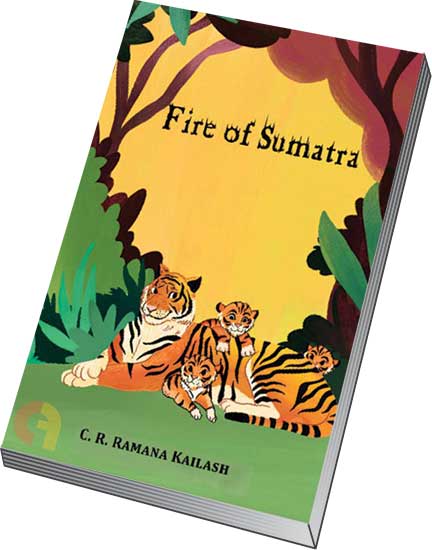Katie Bagli
Ramana Kailash has come up with a brilliant story in his book Fire of Sumatra. Poignant as well as inspiring, his story about how big-time industrialists and palm plantations mafia are ruthlessly destroying the Sumatran forests, completely disregarding the wildlife therein, expresses the maturity of a writer beyond his years (he is currently a class 12 student, and this book was written when he was in class 9). Through the lives of the protagonists – tigers – in the story, Ramana has brought out very clearly all the odds against which wildlife has to survive, in their daily activities of hunting, guarding territories, as well as safeguarding and bringing up their young. Added to this are anthropogenic activities like deliberate fires in their homes and nasty traps which Ali, the tiger, calls ‘death’s hand’. Indeed, the plight of the tigers is brought out in great detail and is sure to tug at the heartstrings.

Ramana has clearly done extensive research to showcase on the one hand, how tigers are walking the tightrope of survival in the face of human activities born of greed, and on the other, how animal lovers working in the field of conservation and protection are going all out, expending all their energy and time to ensure that these majestic creations of nature continue to see the light of day. An interesting and very unusual feature is about how Zalim, the male tiger, looks after his cubs in the absence of their mother, which is not so common among tigers.
Although there are no illustrations in the book, Ramana has painted images so well with the right usage of words that the reader is sure to feel he or she is in that very jungle scene. His story also brings about a strong emotional connect and concern for all wildlife, especially the tiger.
While the language is mostly good, at places more editing would have helped. Since the frequent fires are in the Sumatran forests, the only habitat of the orangutans, a bit more about them could have been added to the story.
All in all, the story is gripping – not a single dull moment in it and reads easily. Good enough for anyone nine years upwards. Teachers can use the story to imbibe values like empathy and compassion for all animals. Ramana’s story will certainly succeed in sensitizing our young and bringing about awareness. From the point of view of creative writing, there are several settings very aptly described with good use of figurative language. I will definitely recommend the book to school libraries.
Let this be the first rung up the ladder to many such books by Ramana that open the eyes of those who do not realize what is happening to the natural wealth of our planet.
The reviewer has authored 40 children’s books so far, almost all of which are on themes of nature and wildlife. She brings out her passion and deep concern for the environment in her stories. Katie is also Education Director of Jane Goodall Institute, India. She can be reached at katiebagli@gmail.com. You can also visit her website www.katiebagli.com to know more about her work.
